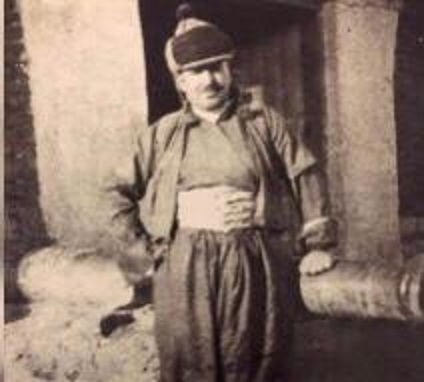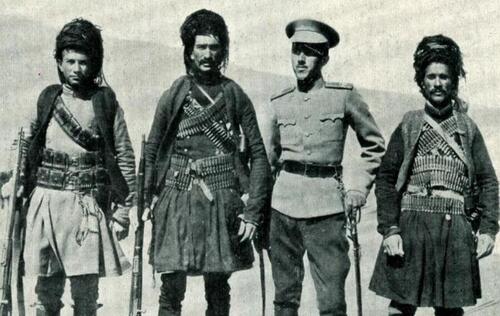Seyyed Taha Nahri and Simko Shikak's meeting with Edmonds of Britain
As the resources written during the revolution of "Simaeel Agha Simko" (Simko Shikak) have revealed and discussed (one of which is "Kurds, Turks and Arabs" by "Cicil J Edmonds") "Simko Shikak" went to the South part of Kurdistan in the end of October 1923 and settled in a village called "Dayra" in the north of Hawler city after a revolution and uprising began in the East part of Kurdistan. Edmonds who was a British political man himself introduces "Simaeel Agha Simko" as a powerful man who was the leader of the Shikak clan. He also talks about Simko Shikak as a man who was controlling a part of Kurdistan beginning from "Kotoul" or "Qotour" village to the borders of Baneh city.

In his book, Edmonds talks about a meeting with "Sayyed Taha Nahri" and also a meeting with "Simko". Edmond's observation of Seyyed Taha and "Simaeel Agha Simko" is precise and accurate and we can even say that as the Orientalists say it is a colonialist observation. He has described their manners and appearances for the reader in detail.
Seyyed Taha and Edmonds Meeting
The description Edmonds presents of Seyyed Taha's height and appearance does not match with a political man's viewpoint. He describes Seyyed Taha as if his political ideas are not important at all and his looks would be more important. He wrote: "Seyyed Taha is a fat man who looks very strong. He could be one hundred and twenty kilograms. He was wearing Kurdish clothes of the North part of Kurdistan; with a pair of loose pants. Stripped pattern pants. He had a Pastak over his shoulders. He was wearing a hat that looked like a helmet. There were some tassels on the edge of his hat like the other Asian hats. Seyyed Taha was a smart, wise, and fat man. He was hardworking. He was also known as a professional shooter."

Seyyed Taha Nahri
Whatever Edmonds says about Seyyed Taha might not be very important for the reader but the reader might ask what was the British demands of the Kurds and what was Seyyed Taha's request on the other hand as a political leader. Based on Edmonds' book, the British were not satisfied with "Sheikh Mahmoud" because he had helped the "Kemalists" out. However, Seyyed Taha talks to the British assuring them that removing the Turks from the southern part of Kurdistan is an easy task since the number of all those Turkish people in the "Raniyeh", "Rwandz" and "Zebar" districts are not more than 250 people. He assumed that with his forces and the "Harki" clan's aid, they could remove the Turkish forces from the Southern part of Kurdistan and gain Britain's satisfaction.

J. Edmonds
What Edmonds mentions in his book indicates that Seyyed Taha did not ask for Kurds' rights or Kurdistan's autonomy in return, but he had demanded to gain the authority of some cities and towns such as "Rwandz", "Akre" and "Amedi" instead thinking he could be like Sheikh Mahmoud who was controlling Suleimani by taking control of Rwandz, Akre, and Amedi. This is what Edmonds has narrated of his meeting with Seyyed Taha in his book. Since there is no other source no one can confirm the truth or falsehood of these claims. However, since Edmonds was related to the powerful men and he also has written about greater and more distinct demands of other Kurdish leaders later in contrast to what he has written in this book, one can assume that he had retailed the meeting honestly and Seyyed Taha's demand was truly for gaining control of a small part of the South part of Kurdistan.
Simko Shikak and Edmonds Meeting
At the same time Seyyed Taha in the South part of Kurdistan, as it has been mentioned in 1923 "Simko Shikak" also went to the South part of Kurdistan but not to Hawler because the British were in this city. Simko did not trust them. He was afraid that his enemies and spies from Iran would know about him. Thus, he acted very carefully by not going to Hawler. Instead, he stayed in "Bahrka" which belonged to the "Gardi" clan. As Edmonds has described Sheikh Taha, he began by describing Simaeel Agha's appearance, his style of clothes, and his companion along with Simko's manners.

Edmonds said "Simko" and his brother "Ahmad Agha" and some other elderly men along with 120 armed men of his were in that place. He said that the lords' clothes were different from the ordinary soldiers' uniforms. The lords were wearing uniformed clothes. Their clothes fabrics were of British fastoni. Their clothes were Khaki color with boots and a hat tied on their heads with Mezar. They also had Pishtwen.
He used the same form of description of every detail of Simko and his companions' clothes, pants, shirts, and overall looks. He considered Simko's physical form very special. He described Simko like this: "He was a thin man of average height. He looked like the Europeans very much. He had a reddish mustache that could make any British officer's face look attractive. He had a beautiful smile. He was a shy man. His little teeth could be seen behind his smiling lips. His manners were like Seyyed Taha's somehow." According to Edmonds' description, he found this group interesting for they had discipline and he considered Simko and his soldiers' looks very important. That is, he paid more attention and importance to Simko's looks rather than Seyyed Taha's. let's see if this importance can be seen in the description of the meeting too. That is if the two subjects of looks and mind had any kind of impact on Edmonds' description as a politician and a writer.

Whatever Edmonds narrates of his meeting with Simko shows us a big difference between Simaeel Agha and Seyyed Taha's understanding of the issues. First, Simko tries to make the British understand that he is not a miserable man. He did not talk to them as a hopeless man. Thus, he began his words by talking about his relationship with the Pahlavi regime. He said that if the issue was having problems with Pahlavi, he did not have any special problem with them because as much as they had harmed Kurds, Simko had harmed them in return. So, if it would be necessary, Simko said that he would resist Pahlavi again and his presence in the South part of Kurdistan did not mean he was a refugee to be sheltered. He said he wanted to realize his nation's demands. He wanted to gain the Kurdish nation's demands through cooperating the powerful states such as Britain. He also talked about his dissatisfaction with the British acts.
To be continued…








